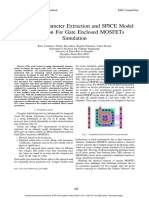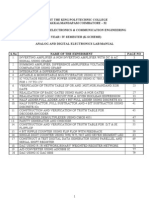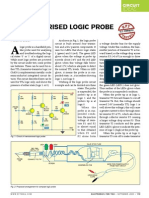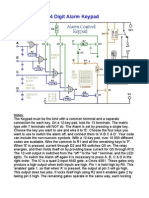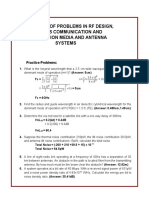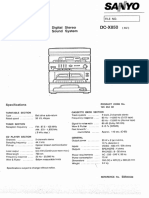Simple Logic Probe
Simple Logic Probe
Uploaded by
srinimd2005Copyright:
Available Formats
Simple Logic Probe
Simple Logic Probe
Uploaded by
srinimd2005Original Description:
Copyright
Available Formats
Share this document
Did you find this document useful?
Is this content inappropriate?
Copyright:
Available Formats
Simple Logic Probe
Simple Logic Probe
Uploaded by
srinimd2005Copyright:
Available Formats
Simple Logic Probe
This circuit effectively functions as a logic-level indicator or logic probe for TTL circuits. It gives an indication of any of the following four conditions that might be found on a typical digital circuit and thus provides a versatile troubleshooting aid: 1. Line high (logic 1) 2. Line low (logic 0) 3. Line tri-state (high impedance) 4. Line changing between high and low state alternately (pulsating). The logic probe is powered from the power supply of the digital equipment under test. The logic state of the line under test is indicated by two LEDs (LED1 and LED2). If the line being probed is at logic 1 (high) state, LED2 would glow brightly. If the line is at logic 0 (low) state, LED2 would be off. If the line is at tristate or open then LED2 would be dimly lit (about half of its full brightness). If the line has a pulsating signal or a clock signal, LED1 would flash on and off at a rate of 1 Hz. Thus LED2 gives an indication of static signal states, while LED1 indicates dynamic signal conditions on the line being probed. The various states of LED1 nd LED2 are summarised in Table I. In order to obtain a visible indication of a clock signal presence on LED1, a divider, which comprises two monostable multivibrators, is made use of. The monoshots are realised using IC1 (dual timer 556). The output of the first monoshot section (pin 5) is applied to the trigger input (pin 8) of the second timer. Assume a clock frequency of 10 kHz is applied to the probe tip. The falling edge of the clock at pin 6 of IC1 triggers the first monoshot section. The output of the first monoshot stays high for around 0.5
seconds and then goes low. This low going edge triggers the second monoshot section, making its output (pin 9) high for around 0.5 seconds. While pin 9 is high, the first monoshot section is prevented from being retriggered with the help of transistor T1. When pin 9 reverts back to the low state, the first monoshot can be retriggered. This arrangement ensures that LED1 flashes on and off at a visible rate of around 1 Hz, thus indicating a clock presence on the line under test. The circuit will detect clock frequencies between 1 Hz and 100 kHz, approximately. For any clock frequency within this range, LED1 will flash at a constant rate of 1 Hz. When the probe tip is connected to a line at logic 1, currents flowing through resistors R9 and R10 add up in LED2 and make it glow brightly. When probe tip is connected to a line at logic 0, the voltage at the junction of resistors R9 and R10 is not sufficient to turn on LED2 (hence it remains off). When the probe is not connected any- where or is connected to a tri-stated line, LED2 remains dim because of current flowing through R9 only. The whole circuit can be enclosed in a small plastic tube with LED1 and LED2 exposed. A pin can be used as the probe tip. The usefulness of this logic probe is limited to low frequency digital circuits.
You might also like
- Error Correction of Loudspeakers, May 2008Document187 pagesError Correction of Loudspeakers, May 2008apdim79No ratings yet
- Chapter 5 Time Domain Response First Order SystemDocument11 pagesChapter 5 Time Domain Response First Order SystemZiad ObeidNo ratings yet
- Alarm System ReportDocument29 pagesAlarm System Reportsyafikahl100% (2)
- PLL & ApplicationsDocument7 pagesPLL & Applications20H51A04K4-CHINTALAPATI MEGHANA B.Tech ECE (2020-24)No ratings yet
- Filters: 1) Capacitor FilterDocument3 pagesFilters: 1) Capacitor FilterJatin hemwani100% (1)
- HiFi Mosfet AmpliferDocument8 pagesHiFi Mosfet AmpliferRajib ChatterjeeNo ratings yet
- Trans Conductance Amp TutorialDocument15 pagesTrans Conductance Amp TutorialrhtmhjnNo ratings yet
- 10 GyratorDocument14 pages10 GyratorPako AlbNo ratings yet
- Capacitor Selection For Coupling and Decoupling Applications - Passive Components BlogDocument11 pagesCapacitor Selection For Coupling and Decoupling Applications - Passive Components BlogVasikaran PrabaharanNo ratings yet
- Characteristics of Diodes, BJT, MOSFETDocument11 pagesCharacteristics of Diodes, BJT, MOSFETvamsiprasannakoduru100% (2)
- OTA High Pass FilterDocument4 pagesOTA High Pass FilterJoel Adrián Amador LópezNo ratings yet
- How Can I Measure Back-EMF To Infer The RPM of A MotorDocument12 pagesHow Can I Measure Back-EMF To Infer The RPM of A Motordcapps_7No ratings yet
- Sawtooth GeneratorDocument23 pagesSawtooth GeneratorOliver TwisteNo ratings yet
- Applications of First Order Differential Equations Discussion Part I PDFDocument22 pagesApplications of First Order Differential Equations Discussion Part I PDFErika Dawn Luciano AmbrayNo ratings yet
- Differential Equations of PhysicsDocument28 pagesDifferential Equations of PhysicsRamesh MishraNo ratings yet
- Poles and ZerosDocument29 pagesPoles and ZerosJane Erestain BuenaobraNo ratings yet
- Cigar Box Synth: InstructablesDocument25 pagesCigar Box Synth: InstructablesmayasfinestNo ratings yet
- Integrals Surface IntegralsDocument53 pagesIntegrals Surface IntegralsanisettimanikantaNo ratings yet
- Circular MotionDocument4 pagesCircular Motionryan valerioNo ratings yet
- Bifilar Coils VS Bucking Coils: The Time Energy Pump ProjectDocument3 pagesBifilar Coils VS Bucking Coils: The Time Energy Pump ProjectTarelli RiccardoNo ratings yet
- Spice Parameter CalculatorDocument9 pagesSpice Parameter Calculatorbkv1409No ratings yet
- Curve TracerDocument2 pagesCurve TracerBellva Butique Irawati Dewi100% (1)
- Automated Parameter Extraction and SPICE ModelDocument4 pagesAutomated Parameter Extraction and SPICE ModelkimjinNo ratings yet
- 60-80W Power AmplifierDocument7 pages60-80W Power AmplifierBerrie SchwarzNo ratings yet
- Greens TheoremDocument2 pagesGreens Theoremjclv.youknow8373No ratings yet
- Zener DiodeDocument7 pagesZener DiodedzNo ratings yet
- Capacitor Meter AutoRanging OLED 128x32 KTW Updated Code 05feb2021Document2 pagesCapacitor Meter AutoRanging OLED 128x32 KTW Updated Code 05feb20214NM20EE085 VISHWAKEERTHI BHAT M100% (1)
- Zener Diode Voltage RegulatorDocument6 pagesZener Diode Voltage RegulatorDark bOYNo ratings yet
- MOS TransistorDocument21 pagesMOS TransistorsivaNo ratings yet
- Digital Electronics Course MaterialDocument54 pagesDigital Electronics Course MaterialMuhammad SalisNo ratings yet
- Pi-Grizzly Twins Metal DetectorDocument13 pagesPi-Grizzly Twins Metal DetectorErasmo MontesNo ratings yet
- ECE 027 - Module 4 Small Signal Amplifier - BJT AC AnalysisDocument40 pagesECE 027 - Module 4 Small Signal Amplifier - BJT AC AnalysisMiyuki NakiriNo ratings yet
- Multiple IntegralsDocument25 pagesMultiple IntegralsAnshulNo ratings yet
- What Is The Difference Between BJT and FET TransistorsDocument16 pagesWhat Is The Difference Between BJT and FET TransistorsgezahegnNo ratings yet
- Varactor Spice Models For RF VCO Aplications PDFDocument4 pagesVaractor Spice Models For RF VCO Aplications PDFZtrea PeniaNo ratings yet
- TL431 Design Tips2 PDFDocument10 pagesTL431 Design Tips2 PDF3degreesNo ratings yet
- Laplace Transform TableDocument3 pagesLaplace Transform TableNasir NaeemNo ratings yet
- BJT DC Parameter EstractionDocument67 pagesBJT DC Parameter EstractionJuan R Ayala-OlivaresNo ratings yet
- 7805 Voltage RegulatorDocument3 pages7805 Voltage Regulatormukesh80125100% (1)
- Gyrator Capacitor ModelingDocument7 pagesGyrator Capacitor Modelingbenitogaldos19gmail.comNo ratings yet
- Interactions Between An Input Emi Filter and A Power SupplyDocument4 pagesInteractions Between An Input Emi Filter and A Power SupplyStephane Brehaut PhD Ceng SMIEEENo ratings yet
- BJT Model From DatasheetDocument14 pagesBJT Model From DatasheetAngel Pérez SantiagoNo ratings yet
- Analog Circuits II Lab ManualDocument47 pagesAnalog Circuits II Lab ManualParesh SawantNo ratings yet
- Preface: The Maximum Flux Density Is Obtained When The Transformer Is Idle. Please Don'tDocument20 pagesPreface: The Maximum Flux Density Is Obtained When The Transformer Is Idle. Please Don'tMudasurNo ratings yet
- 6 Line Integrals NotesDocument7 pages6 Line Integrals NotesSafdar AbbasNo ratings yet
- Logic Gates 1Document17 pagesLogic Gates 1saurav chauhanNo ratings yet
- Diode Clamping CircuitsDocument4 pagesDiode Clamping CircuitsftafedeNo ratings yet
- LT Spice - Transformers - (By Mike Engelhardt)Document2 pagesLT Spice - Transformers - (By Mike Engelhardt)kimbalsummers801No ratings yet
- Adjustable Duty-Cycle OscillatorDocument3 pagesAdjustable Duty-Cycle Oscillatoracidreign100% (1)
- Ece Ade Manual 500 CopiesDocument79 pagesEce Ade Manual 500 CopiesRajkumarNo ratings yet
- Guide: GyratorDocument11 pagesGuide: GyratorJulio César GuardiolaNo ratings yet
- DSP Lab Sample Viva QuestionsDocument7 pagesDSP Lab Sample Viva QuestionsNikoBellicNo ratings yet
- Inductance and Capacitance Meter Adapter Using 74HC132Document6 pagesInductance and Capacitance Meter Adapter Using 74HC132Miguelangel Bravo MigoneNo ratings yet
- User Guide: Constant-Current-Draw AmplifierDocument20 pagesUser Guide: Constant-Current-Draw AmplifierHuythuong NguyenNo ratings yet
- TTL ProbeDocument2 pagesTTL ProbeSaadNo ratings yet
- 3.4-TESTER DE PULSOS DIGITALES 1-0-PULSOS Fabricado Con NANDDocument2 pages3.4-TESTER DE PULSOS DIGITALES 1-0-PULSOS Fabricado Con NANDDavid molinaNo ratings yet
- CI 5 Watchman WatcherDocument2 pagesCI 5 Watchman WatchersarmasarmatejaNo ratings yet
- Dancing LightDocument10 pagesDancing LightSurajj KumarNo ratings yet
- Intro To Embeddedwith Win Embed CE2 ND EdDocument400 pagesIntro To Embeddedwith Win Embed CE2 ND Edsrinimd2005No ratings yet
- 8 Watt Audio Amp: Part Total Qty. DescriptionDocument1 page8 Watt Audio Amp: Part Total Qty. Descriptionsrinimd2005No ratings yet
- 4digit Alarm KeypadDocument2 pages4digit Alarm Keypadsrinimd2005No ratings yet
- Imagine Cup 2012 Software Design RulesDocument11 pagesImagine Cup 2012 Software Design Rulessrinimd2005No ratings yet
- MythsDocument324 pagesMythssrinimd2005No ratings yet
- Anna University Tiruchirappalli: Tiruchirappalli - 620 024 Syllabus B.Tech. Information Technology Semseter IiiDocument18 pagesAnna University Tiruchirappalli: Tiruchirappalli - 620 024 Syllabus B.Tech. Information Technology Semseter Iiisrinimd2005No ratings yet
- Performance Evaluation of GSM NetworkDocument11 pagesPerformance Evaluation of GSM Networkማሙየ አይቸውNo ratings yet
- Compilation of ProblemsDocument10 pagesCompilation of ProblemsCindy AyenNo ratings yet
- A History of U.S. Navy Airborne and Shipboard Periscope DetectionDocument31 pagesA History of U.S. Navy Airborne and Shipboard Periscope Detectiong960405No ratings yet
- Snapdragon 865 5G Mobile PlatformDocument6 pagesSnapdragon 865 5G Mobile PlatformVladimir VasiljevskiNo ratings yet
- Audio - Majority Fitzwilliam 3Document222 pagesAudio - Majority Fitzwilliam 3Jesús PrietoNo ratings yet
- Waves pdf100Document15 pagesWaves pdf100Klaus SchneiderNo ratings yet
- Work FM Sats-20131010 PDFDocument4 pagesWork FM Sats-20131010 PDFFunke Oni-alaoNo ratings yet
- Sample of Written Examination QuestionsDocument50 pagesSample of Written Examination QuestionsBirthwell MbiriNo ratings yet
- Two-Way Screenarray Cinema Loudspeakers: Key FeaturesDocument4 pagesTwo-Way Screenarray Cinema Loudspeakers: Key FeaturesRajuNo ratings yet
- Sanyo dc-x850 SMDocument40 pagesSanyo dc-x850 SMAKNo ratings yet
- Azur 640A User Manual - All LanguagesDocument114 pagesAzur 640A User Manual - All LanguagesMarkNo ratings yet
- S6 ManualDocument81 pagesS6 ManualAlexander BudnikNo ratings yet
- Airworthiness Directive: Design Approval Holder's Name: Type/Model Designation(s)Document5 pagesAirworthiness Directive: Design Approval Holder's Name: Type/Model Designation(s)TusharRoyNo ratings yet
- CoC CRV Crew Training ManualDocument301 pagesCoC CRV Crew Training Manualalfredo avilaNo ratings yet
- Edge Air 1417Document126 pagesEdge Air 1417Meding Internacional SacNo ratings yet
- Owner's Operation Manual - 18,000 - 48,000Document15 pagesOwner's Operation Manual - 18,000 - 48,000Amine FadlaouiNo ratings yet
- Osciloscop Digital Atten ADS1202CML - Osciloscop Digital de Laborator, 200MHz, 1GS - S, Afisaj Colo LCD 9Document3 pagesOsciloscop Digital Atten ADS1202CML - Osciloscop Digital de Laborator, 200MHz, 1GS - S, Afisaj Colo LCD 9sorin-itNo ratings yet
- 06-Inv Noninv AmpDocument3 pages06-Inv Noninv AmpharshNo ratings yet
- 01 ULO2a, KBP, NTCDocument94 pages01 ULO2a, KBP, NTCMelrose LopezNo ratings yet
- Green House Monitoring Using GSMDocument47 pagesGreen House Monitoring Using GSMArun Kumar Yadav100% (7)
- Panasonic PROJECTOR TV TX-43P950XDocument102 pagesPanasonic PROJECTOR TV TX-43P950XTV GaGa hsfNo ratings yet
- Eon One Pa PDFDocument20 pagesEon One Pa PDFManoel Vitorino JuniorNo ratings yet
- TCXD 46-1984 / Lightning Protection For Buildings - Standard For Design and ConstructionDocument30 pagesTCXD 46-1984 / Lightning Protection For Buildings - Standard For Design and ConstructiontrungjindoNo ratings yet
- Petrobel ZoserDocument20 pagesPetrobel ZoserTamer SeifNo ratings yet
- Inmarsat-C Mes Model Felcom18Document64 pagesInmarsat-C Mes Model Felcom18Edi GunawanNo ratings yet
- BS 3923 - 1972 PDFDocument20 pagesBS 3923 - 1972 PDFhusain1976No ratings yet
- Led TV : Owner'S ManualDocument24 pagesLed TV : Owner'S ManualAleksandar DamljanovicNo ratings yet
- GSM OptimizationDocument34 pagesGSM OptimizationBAMS2014No ratings yet
- Bravia - kd65xf7096 ManDocument20 pagesBravia - kd65xf7096 ManMarijan TvNo ratings yet

























